main: March 2011 Archives
 From the December edition of NewMusicBox.org, comes "An Arts Education Symposium," with the great Maxine Greene, Hollis Headrick, Polly Kahn, Frank Oteri, and me.
From the December edition of NewMusicBox.org, comes "An Arts Education Symposium," with the great Maxine Greene, Hollis Headrick, Polly Kahn, Frank Oteri, and me.For those who don't know Polly, she's the former education director at The New York Philharmonic, the 92nd Street Y, and other organizations. Today, she is the vice president for learning and leadership development, at the League of American Orchestras.
Oteri, a well known figure in the new music world, was once a teacher at one of the toughest high schools in New York: Thomas Jefferson High School.
Hollis, I am sure there are few in the arts education field who don't know him...
It was a terrific conversation, one that was supposed to be focused on Maxine Greene, but she was determined to serve us dinner, so it turned out less of focused on Maxine, and more of a free for all.
Click here to read An Arts Education Symposium, from NewMusicBox.org
Here's a wonderful excerpt:
MAXINE GREENE: Yeah. Dewey says that democracy is a community in the making. And always like that, because it means you never really achieve it, but it's in the making through community... That's why he uses Whitman as the poet of democracy. And if we could say that schools should be communities in the making, you know, or, like he talks about an articulate public, giving a public its voice... I think they're all very similar. It's such a funny place to say it. Art reaches a deeper level of awareness and that ordinary conversation is so trivial and so superficial, but if it touches the level of the arts, desire and purpose come to the surface, you know. And I think it, you know, you get fewer sound bytes, if you can somehow be in touch. And a lot of people are talking, oddly enough, about Eros now, in connection with schools. Desire, passion, they're trying to spoon it back, you know.

I mean, how often do you get a rising star principal, a teachers union leader, and a member of the governing board for state education policy in one room together talking about arts education?
A WELL-ROUNDED EDUCATION IN THE AGE OF HIGH STAKES ACCOUNTABILITY - IS THERE REALLY TIME AND SPACE FOR THE ARTS?
March 19th, 8:30-9:45 am, New York Hilton
School leaders face greater pressure around standardized tests and other performance measures than ever before. In an era of high-stakes testing, performance-based pay, and school turnaround, all compounded by dramatically declining budgets, can time and space really be afforded for subjects like arts education?
Join: Ramon Gonzalez, Principal of MS223 in The Bronx, Aminda Gentile, Vice President for Educational Issues, United Federation of Teachers, and Roger Tilles, Member, New York State Board of Regents, n a conversation moderated by Richard Kessler of The Center For Arts Education, as they discuss the details and implications for policy, of how MS 223 has partnered with the USDOE and CAE to build the necessary capacity to provide all students with a well-rounded education that includes the arts, while at the same time becoming the only school in New York State to win a 2010 Intel School of Distinction Award.
If We're Not At the Table, We're On the Menu: Will the Arts Survive This Time as Education in Our Schools?
At the Face to Face Conference at the Frank Sinatra School of the Arts in Queens a few weeks ago, some of my colleagues and I engaged in a panel presentation and discussion with an attentive and thoughtful audience. We had several guiding questions that boiled down to what concrete actions we might take to secure a place for the arts in the general curriculum. I focus here on only one aspect of our discussion: the table.
Richard Kessler (The Center for Arts Education) stressed the importance of being at the table when and where the arts, teaching and learning are at stake. Hollis Headrick (former CAE director and current consultant) reinforced Kessler's point with the witticism in this blog's title -- if we're not out there making the irrefutable case for the arts for all the kids, we'll be "eaten alive." Kyle Haver (Associate Director of Leadership and Organizational Learning, NYC Dept. of Education) suggested we seize the opportunity to develop specific steps and a strategy to connect the arts as content and context to the ELA and other subject areas in the Common Core State Standards.
Distilled, the message was simple: if those of us who have championed the arts for years don't figure out how to ally ourselves with other arts, education and community forces and insist on being at power breakfasts, lunches, dinners, meetings, and political venues, given the current climate and circumstances, we will continue to be ignored, and risk slipping entirely off the educational radar screen.
During the question and answer period, my longtime friend and colleague, Carol Fineberg, raised several questions, one of which galvanized a flurry of responses: where is the table and how do we get access to it? Some brief, bulleted thoughts for you to "chew on", (to keep up the culinary metaphor):
• There is no one table. And, certainly no one table of power "at the top." Power is slippery so it is crucial for us to gather together to create our own local tables, school by school, district by district and work at the grass roots level where there is a shred of possibility of having influence, confidence and sustained impact.
• We must come prepared to design plans of action at the local level, to collaborate with both the usual and unusual suspects; it is time to move outside the box and tap varied forces.
• The unit of change is one school at a time, perhaps one network at a time, and with difficulty, one district, only of the entry points are open and there is flexible dedication.
• Working with and within the Common Core State Standards is, at the moment, a strong and compelling idea. But as I remember what American history tells us, especially since 1983 Nation At Risk bombshell, standards come and go (at least three sets since then - National, Naep and various states), and standardized high stakes testing in English and Math remain the gold coin of the realm. There is no guarantee that the money, energy, or infrastructure (professional development, assessment and evaluation smarts, and the constraints of time and enthusiasm) required for success will emerge or last in our current fragile economy and divided nation.
• Whatever we do takes time, money, focus, patience, and persistence. Do we have it? Is this the time? How do we organize and work from the ground up. Can we achieve solidarity?
• Speaking of leadership, who is the we?
Let me know your thoughts. Meanwhile, what counts for me is working with those schools, communities and cultural organizations that are steadfast in their beliefs that the arts are education. *************************************************************************************************************** JANE REMER'S CLIFFNOTES We are at another rocky precipice in our history that threatens the survival of the arts in our social fabric and our school systems. The timing and magnitude of the challenges have prompted me to speak out about some of the most persistent issues in the arts education field during the last forty-plus years. My credo is simple: The arts are a moral imperative. They are fundamental to the cognitive, affective, physical, and intellectual development of all our children and youth. They belong on a par with the 3 R's, science, and social studies in all of our elementary and secondary schools. These schools will grow to treasure good quality instruction that develops curious, informed, resilient young citizens to participate fully in a democratic society that is in constant flux. I have chosen the title Cliff Notes for this forum. It serves as metaphor and double entendre: first, as short takes on long-standing and complicated issues, and second, as a verbal image of the perpetually perilous state of the arts as an essential part of general public education. I plan to focus on possible solutions and hope to stimulate thoughtful dialogue on-line or locally. ***************************************************************************************************************
 Jane Remer has worked nationally for over forty years as an author, educator, researcher, foundation director and consultant. She was an Associate Director of the John D. Rockefeller 3rd Fund's Arts in Education Program and has taught at Teachers College, Columbia University and New York University. Ms. Remer works directly in and with the public schools and cultural organizations, spending significant time on curriculum, instruction and collaborative action research with administrators, teachers , students and artists. She directs the Capezio/Ballet Makers Dance Foundation, and her publications include Changing Schools Through the Arts and Beyond Enrichment: Building Arts Partnerships with Schools and Your Community. She is currently writing Beyond Survival: Reflections On The Challenge to the Arts As General Education. A graduate of Oberlin College, she attended Yale Law School and earned a masters in education from Yale Graduate School.
Jane Remer has worked nationally for over forty years as an author, educator, researcher, foundation director and consultant. She was an Associate Director of the John D. Rockefeller 3rd Fund's Arts in Education Program and has taught at Teachers College, Columbia University and New York University. Ms. Remer works directly in and with the public schools and cultural organizations, spending significant time on curriculum, instruction and collaborative action research with administrators, teachers , students and artists. She directs the Capezio/Ballet Makers Dance Foundation, and her publications include Changing Schools Through the Arts and Beyond Enrichment: Building Arts Partnerships with Schools and Your Community. She is currently writing Beyond Survival: Reflections On The Challenge to the Arts As General Education. A graduate of Oberlin College, she attended Yale Law School and earned a masters in education from Yale Graduate School.
The great tubist and brass teacher Arnold Jacobs implored his students to think: wind and song.
There are those who seem to go in an opposite direction, meaning vocalists who appear to turn the voice into something that is more like an instrument.
A great deal of it has to do with vocal performance without words or few words. And, when I hear this type of performance, it makes good on the classification of voice as instrument.
I thought it would be fun to post four different vocalists who are able to create their own worlds of sound with their voice, in ways truly extraordinary.
The first, is a somewhat forgotten artist: Karl Denver. What Denver does with Wimoweh is pretty amazing, particularly for 1964, in a popular genre..
Next up is Joan LaBarbara. When Joan performs solo, she creates her own world of music and sound. It's like magic. She's pretty much the Houdini of new music.
Here's an excerpt of Joan performing Christian Marclay's Magna Scroll, at The Whitney.
And here's a clip from the documentary film on Meredith Monk. People sometimes wonder: is she an actress, a choreographer, a composer, and musician, a dancer, a producer...?
I do know that Meredith describes herself as a composer.
And the last of these great examples of the voice as an instrument is Bobby McFerrin. I so often hear magic in what he does, and sometimes, just the sheer sound of his voice gives me great pleasure.
And finally, I bring to you great Jack Teagarden. He hails from a time when a trombonist could be a big star. And, one of the truly remarkable things about his performing, what that he played like he sang, and sang like he played. Confused? Give a listen to see what I mean.
A lot of attention has been paid to the recent report commissioned by the arts endowment: Arts Education in America: What the Declines Mean for Arts Participation.
I thought it would be a great opportunity to pose some questions for the author, Nick Rabkin.
Let's just say that rather than leave interpretation to others, that it's always best to hear directly from the horse's mouth.
Many people are seizing upon this report as a sort of smoking gun for how cuts to arts education lead to cuts to arts participation, and conversely how increasing access to arts education would lead to an increase in arts participation. Presumably, it's a good part of what Rocco Landesman was using as a research based rationale for urging arts organizations to increase arts education. In this instance, it was a prescription for increasing demand.
I have known Nick Rabkin for many years and am a big, big fan of his work. I am really glad that he was able to take the time from his busy schedule to answer a few questions. --RK
*************************************************************************************************************** March 2011, Q&A With Nick Rabkin
1. What were your research questions?
The NEA's SPPA surveys have tracked adult participation in the arts since 1982. The NEA is particularly interested in attendance at what they call "benchmark" events--mostly performances and exhibitions presented by not-for-profit arts organizations--but the surveys track some other forms of arts participation as well, including arts education. The NEA commissioned my study and several others because the data shows that the rate of benchmark attendance has declined pretty significantly since 1992. That's a deep concern to the not-for-profits and the NEA, and it is probably what prompted Chairman Rocco Landesman's recent remarks about lagging demand and oversupply in the arts.
Our first question was to determine the strength of the relationship between arts education and adult participation in the arts. How strong is it? And has it been consistent over time across all of the SPPAs? Second, we wanted to probe the data to see if we could better understand what has happened to arts education over time. Has arts education had declined along with other forms of participation over the years? Some recent studies have suggested that increasing arts education might be vital to strategies to increase arts participation, so our third question was about whether there was evidence in the SPPA data that supported that idea.
2. What were your main findings?
We found that arts education is the single most powerful "predictor" of adult arts participation. Other variables, like educational attainment and income also had strong relationships to arts participation, but none had a stronger association with benchmark arts attendance or with personal creation or performance than arts education. Note that I'm using the word "predictor" here, not "cause." More arts education as a child or as an adult makes it likelier that people will participate in the arts as adults. That statistical relationship suggests that arts education is a contributing cause of adult arts participation. This finding is significant, but not a big surprise. It important to recognize that many, many influences contribute to adult decisions to participate in the arts.
All the SPPAs asked questions about people's experiences with arts education as children. We looked at the proportion of 18 - 24 year-olds who reported that they had any arts classes or lessons (in-school or out) before they turned 18, and found the proportion had declined in each survey--from a high of about 65% in 1982 to under 50% in 2008, a serious drop. Since the surveys covered a representative sample of Americans, including older Americans, they included data about childhood arts education that went back long before 1982. We found the proportion that had classes or lessons as children had risen steadily from 1930, when less than 25% had any arts education, until the early 1980s, when the proportion began declining. Access to arts education rose for American children by about 180% from 1930 to 1985. It has declined by a quarter from 1985 to 2008.
(Note that those dates refer to years in which survey respondents turned 18. Their childhood experiences occurred prior to those years, of course. So the decline in childhood arts ed began before 1985 - probably in the 1970s, when fiscal crises in most major school districts and taxpayer resistance to public services like education combined to force deep cuts in school districts across the nation.)
When we looked at how that decline was distributed among American children, we found that most of the decline has been concentrated among African American and Hispanic children. There was only a small decline among white children.
When we examined how the decline was distributed among art forms, we found that it was concentrated in visual art and music, the two arts forms most frequently taught in schools. (In fact, there were small gains for both theater and dance, which are both mostly taught outside schools.) So the data shows that most of the decline in childhood arts education has been in schools, and most of that has occurred in schools that serve minority children.
3. If participation in K-12 arts education is a strong predictor of adult arts participation, why wouldn't declines in access to arts education be a contributing factor in declining levels of arts participation? What is wrong with that assumption?
I think the argument holds water, but I also believe that the effects go in both directions. In other words, education policymakers who do not themselves participate in the arts are probably less inclined to value arts education and make policy that supports it in schools. The relationship is dynamic and bidirectional, not linear.
4. Is the strategy of audience development through arts education is problematic?
Well, it is certainly problematic if you are looking for a quick turnaround. But it should be a foundation for any strategy that looks to the long term, though. That is easier said than done, since the long-term decline in arts education does not appear to be slowing down in this recession. What's more, the trends in school reform for over thirty years have not been friendly to arts education. Intense focus on high stakes standardized tests and punitive accountability have narrowed curriculum and made it more difficult for good principals and teachers to carve out time for arts education. So the problems for the arts and arts education are linked in a vicious cycle. It will be hard to break that cycle until education policymakers realize that the basic strategies of reform have not moved the needle for student achievement and that we need to (finally) grow beyond the old factory model of schooling. There are emerging and hopeful signs that could be starting to happen (and some less hopeful signs that the recession and fiscal crisis are constraining creative impulses in education policy).
5. Most of the available research around the status of arts education is based upon what is offered, as opposed to what students actually receive. What were you able to determine regarding what is offered and what were you able to determine regarding real levels of student participation? Do you believe this distinction is important?
That's what makes the SPPA data so valuable. It actually shows how many Americans took arts classes or lessons as children and as adults, not whether the schools they attended offered classes. That is a more accurate way to measure what matters - whether students are getting access to arts education.
6. Did the data reveal anything about how and when the arts education was delivered? For example, in-school by certified art teachers or by teaching artists? Or out of school time?
The SPPA data is limited and not very granular, so we can only see broad trends in it. In some survey years there were questions about whether people had taken their arts classes in school, out of school, or both. That is how we know that nationwide music and visual arts are offered far more than theater and dance in schools. But some surveys did not ask where the classes were. And none of the surveys asked people about who taught the classes, or the intensity, longevity, or quality of the experiences. We might speculate that longer and better instruction would have a stronger association with future participation, but we only know if people had "any" classes or lessons in music, dance, theater, visual art, or creative writing as children. We can't distinguish between someone who had ten years of private lessons on the clarinet and someone who had six weeks of recorder lessons in their fourth grade classroom. They both could answer 'yes' to the question on the survey.
7. What do you think is the importance of this report?
Most advocates have believed that there has been a long-term decline in arts education for children, and we've had much anecdotal evidence of deep cuts in many districts, but there has been no reliable record of the picture across the country. Some have speculated that there were increases in arts education during the 1990s that were rolled back when No Child Left Behind became the template for national school policy. The NEA
s Survey of Public Participation in the Arts (SPPA) data gives us very strong statistical substantiation that arts education has been a major casualty of school reform and budget cuts, that the damage began in the 1970s or 80s and continued through the 90s. All of the effort to develop arts standards and establish the arts as a 'core' subject in the 90s did not change the downward trajectory, and NCLB sustained the long trend. Since the biggest victims have been low-income minority children in schools where they are concentrated, arts education is an equity and a civil rights issue. (Thanks for making that point in your blog post, Richard.)
The report also proves that there is a very powerful relationship between arts ed and participation. That is most important to arts organizations that present the arts and to artists, but it doesn't cut it as a reason to change educational policy. There is a growing body of terrific research that shows the power of arts education to improve student performance and motivation in schools. We need to learn from it, build on it, and use it to demonstrate to policymakers that arts education can help them solve the problems that keep them awake at night.
8. When will your report on the state of teaching artists be released, and are you as excited about it as almost everyone I know is?
Thanks for asking. No one is more anxious to complete that study than I. We've collected a mountain of data - 3500 surveys and over 200 in-depth interviews in a dozen communities across the country. Most of the analysis is finished, and I'm writing feverishly every day. I hope the finished product will be available in two or three more months. Here's a preview: Teaching artists are important in communities and schools everywhere. They offer essential and in-depth arts ed resources for young people that schools will never be able to provide. Especially since the 1980s and 90s, they have been bringing fresh insight and practice into arts education in schools, exactly the kind of innovation that need badly if they are to become more dynamic places for learning. Stay tuned. More to come soon.
Childhood arts education rates, 1930 - 2008
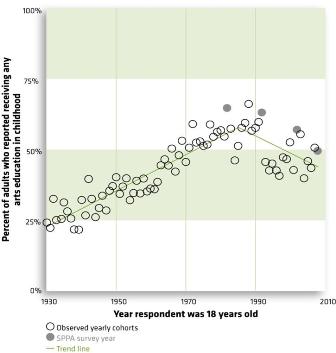
Arts education rates by race, 1982 - 2008
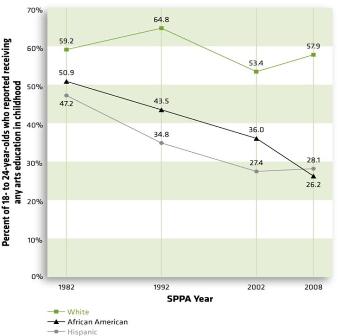
*************************************************************************************************************
Nick Rabkin's career in the arts began with work for Chicago's Organic Theater Company, producing new works for the stage. He was also deputy commissioner for cultural affairs for the City of Chicago, and the senior program officer for the arts and culture at the John D. and Catherine T. MacArthur Foundation. He was the director of the Center for Arts Policy at Columbia College Chicago for seven years, and is now a senior research scientist at NORC at the University of Chicago and a research affiliate of the Center for Arts Policy at the University of Chicago. Throughout his career he has been particularly interested in the ways that the arts contribute to the quality of democratic life - especially with regard to social relations, development, and education. He's written widely on arts education, including the book, Putting the Arts in the Picture: Reframing Education in the 21st Century. He expects to complete the first large scale study of teaching artists in a dozen communities - from Providence to San Diego - in the near future.
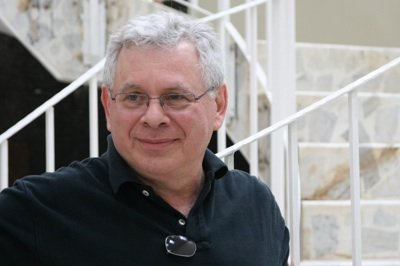
*************************************************************************************************************
For all of those concerned about draconian cuts to arts education programs at the United States Department of Education, including everyone who has been contacting elected officials and their staff, I would like to point out something that came across my desk this morning, from Politico Playbook:
SCHUMER TO CALL FOR "RESET" of BUDGET DEBATE - wants to include tax reform in budget deal -- Speech at 9:15 a.m., Center for American Progress - From release: Sen. Charles Schumer (D-N.Y.), the #3 Senate Dem., "will point to the lessons of the 1990s when President Clinton balanced the budget with a plan that didn't just cut domestic discretionary spending, but also tackled mandatory spending and reformed the tax code. The senator will say that a similar 'all of the above' strategy is needed in any deal struck on a continuing resolution for the rest of this fiscal year. Schumer will criticize House Republicans' current approach for focusing narrowly on domestic discretionary spending. He will say that approach not only is harmful to economic growth, but also does not meaningfully reduce the deficit. Instead, Schumer will call for the ongoing negotiations led by the White House to 'broaden the playing field' when it comes to deficit reduction and include mandatory spending cuts and tax code reforms as part of any final compromise."
Of course, the absence of arts education as a subject among leaders public education bloggers is something I lament.
So, I took a keen interest in one blog entry and an associated tweet about arts education, from Petrilli writing on the Flypaper blog.
Upon reading an Ed Week piece about the recent NEA report, Arts Education in America: What Declines Mean for Arts Participation, Petrilli sent out a tweet blaming the declines in arts education on the teachers unions.
Then, he realized that a 28 year decline in access, predominately for African American and Hispanic children could not be blamed on teacher unions.
What is more, Petrilli has picked up this issue a bit more and is now recognizing what an easy target arts education is for many district and school leaders who should know better by now.
Click here to read Arts Education on the Ropes, by Mike Petrilli.
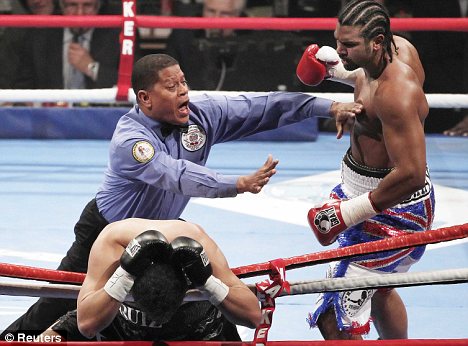
Key Policy Letters to The Governors, March 3, 2011
What you will find most interesting comes from the document Smart Ideas to Increase Educational Productivity and Student Achievement:
First, Do No Harm
Changes or cuts to education budgets, especially during periods of fiscal austerity, carry risks of unintended consequences. Governors, policymakers, and educators can:
ü Avoid short-sighted cost-cutting. Efforts to increase productivity should not be mistaken for the short-sighted cost-cutting many states and districts have engaged in over the years to reduce education spending. Even in an era of tight budgets, cutting back in a manner that damages educational quality and hurts children is the wrong thing to do. Short-sighted cuts include: reducing the number of days in the school year, decreasing the amount of instructional time, eliminating instruction in the arts and foreign languages, eliminating high-quality early learning programs, abandoning promising reforms, and indiscriminately laying off talented teachers be they new, mid-career, or veteran. Decision-makers should be able to take advantage of other options for cost-saving before resorting to such potentially harmful approaches. Only some of these decisions will be made at the state level, but governors and other state policymakers can provide districts and schools with guidance, incentives, and flexibility to make necessary cuts in ways that put student learning first.
In this case, it's an old and quite sore subject. And yes, it's a subject that makes me angry and eager for new city leadership. For all of those who tell me I should be more guarded, sorry.
In what many still argue is the arts capital of the world, the public school system can't find a way to provide a minimum of one year of arts education for all middle school students.
While real education leaders like Michael Hinojosa in Dallas Independent School District are protecting their arts teachers from cuts, even while 4,000 teachers face layoffs, New York City loses 5% of its arts teachers and is preparing to cut another 15%. This comes on top of a 69% cut to funding of arts supplies and a 31% cut for services of cultural organizations, all before the great recession began in 2008.
Click here for Arts Teachers Becoming Endangered Species in City Schools--Even Before Massive Layoffs, by Meredith Kolodner, NY Daily News.
City schools are already down 135 arts teachers - even before the massive layoffs projected for next year, Education Department data show.
Last year, public schools employed 2,462 arts teachers, down from 2,597 the year before. This drop erased the slow gains arts education had made over several years.
Now an additional 356 arts teachers risk pink slips as part of the proposed layoff of 4,600 teachers citywide - a cut that would bring the number of certified arts teachers down by close to 20% over three years.
If trustees sign off on the budget proposal, it will mean the end of all elementary music education except for the program at Crown Pointe Junior Music Academy, which does not rely on visual and performing arts funding.
Click here to read: School Music, Arts Programs on the Chopping Block, The San Diego Union-Tribune (SignonSandiego.com)
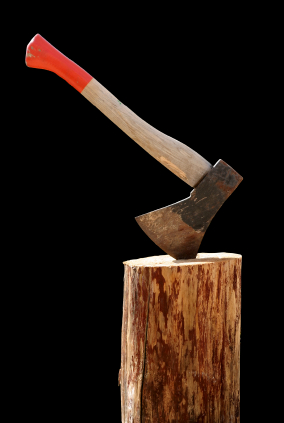
So. take the time, you won't be sorry.
And, for more background on Diane, and the myths out there about her, click on through to The Answer Sheet, by Valerie Strauss: The Diane Ravitch Myth.
This all underscores the sad level of debate on education policy in this question. We can't even agree on the questions, much less the answers. And those that dare deviate from the official line find themselves open to attack, much of it not fair. At least if you are Diane Ravitch.
Here's a little list of some of the cuts:
Tweet
- Arts in Education--$40 million
- National Writing Project--$25.6 million
- Teach for America--$18 million
- Reading is Fundamental--$24.8 million
- National Board for Professional Teaching Standards--$10.7 million
- New Leaders for New Schools--$5 million
- We the People--$21.6 million
- Close Up fellowships--$1.9 million
- Exchanges With Historic Whaling and Trading Partners--$8.6 million
- Thurgood Marshall Legal Educational Opportunity program--$3 million
- B.J. Stupak Olympic Scholarships--nearly $1 million
For those of you that might think using the term "death panel" is in bad taste and hyperbolic, no matter how one might define the politically hijacked term, think again. These cuts may very well kill some very fine and important organizations, as well as programs, providing invaluable services for children across America. And if you've ever spent time in under-served urban schools, you would understand the great value of these programs.
It's a stunning list, both big and small. Politically powerful (and able to withstand the hit), such as Teach for America and New Leaders for New Schools, as well as more under the radar programs such as the arts education initiatives at the US Department of Education.
For organizations like the National Writing Project, which depends on the feds for half of its budget, with the other half from local matching grants, this bill may very well be the equivalent of a death panel decision.
If you have the patience, click here for a detailed budget FY11 Education Department Budget document.
What is more, these funding lines, which are not earmarks by any reasonable definition, have been identified as such, thus providing cover for a hatchet job.
A group of senators registered their protest.
Keep this in mind: 100 democratic members of congress voted for this bill.
So, what does one make of all this?
Well, there is an interesting editorial in today's New York Times: The Hollow Cry of Broke. In essence, based upon emerging polling data, it says that these cuts, as well as the attacks on labor, are an overreach. The editorial implies that these cuts and political attacks (which are all in my view a move to restore the nation to what we had in the Hoover administration) will ultimately result in a boomerang effect.
If you read these tea leaves closely, it might just give you a sense of the strategy developing in the White House and Democratic Party, something not quite discernible, as the Democrats struggle to with how to gain the rhetorical high ground.
But now voters are starting to notice the effects of these cuts and to get angry at the ideological overreach. A New York Times/CBS News poll published on Tuesday showed that Americans oppose ending bargaining rights for public unions by a majority of nearly two to one. And the poll sharply refutes the post-Reagan Republican mantra that the public invariably abhors all tax increases. Nearly twice as many people said they would prefer a tax increase to cutting benefits of public employees or to cutting spending on roads.Over the past two days, I have been in close touch with two colleagues who are leaders in terms of Federal issues and the arts: Narric Rome, of Americans for the Arts, and Heather Noonan, of the League of American Orchestras. (I do want to acknowledge and thank them for being such great colleagues.) We've been working together to get the word out and help craft action from all of those who have arts education programs funded by the United States Department of Education.
There is still some chance that a more positive result could come about through the next, long-term CR (continuing resolution). The one silver lining, perhaps, is that I have this feeling that this may just be one great opportunity to advance arts advocacy. Maybe it will take these sorts of events to create new possibilities for how the field can work together and with other sectors to advocate for children, education, and the arts.

So, here's my tack-on, making for a trio on the subject.
Today, much of the K-12 education debate is being framed by what a student needs to know and be able to do in college and career. What is more, increasingly, educators are looking at continuum of education that is P-16, rather than K-12, meaning Pre-K through undergraduate degree.
If we view college as part of a P-16 continuum, and ask the fundamental question of what an arts college graduate needs to know and be able to do in the 21st century, as opposed to say the 19th century or even 20th century, then, through a backwards mapping approach we could rethink not only arts colleges, but the key relationship between elementary, secondary, and post-secondary education.
In essence, that question should lead to a framing of the sort of outcomes for entrepreneurial training that Jim and Andrew speak of, while providing something even more basic: outcomes that guide the overall educational experience.
Arts degrees, particularly in the performing arts, which comprise the vast majority of activity that Jim Undercofler is concerned about in his entry, has an additional challenge, one that can also draw from advances in K-12, and that is found within the evolving area of Career and Technical Education.
I realized that I will probably get a lot of grief for saying this, but I have often thought that the degrees in the performing arts more closely resembled career and technical education than more purely academic areas. Now, if the term career and technical education it throwing you for a loop, it's what was formerly known as vocational-technical education, or "Vo-Tech." My dad graduating from Automotive High School in the late 1930's--that was a a Vo-Tech high school as opposed to an Academic High School.
While some may resent my associating a degree in instrumental music to a technical degree in let's say plumbing, as a general and fairly consistent observation over many years, what I have found is that most performing artists, particularly in music, have significantly less interest in any study that is not based in performance. Thus things like music history, music theory, English, and other non-performing- based areas tend to be suffered by the students and given relatively short shrift by the enterprise that is driven by performance-based study.
Now, there are some paradoxes here that cannot be addressed but for a future entry, including the fact that there is a great deal in quality performance-based teaching and learning that could benefit teaching and learning overall in K-12, including the sequential learning, great care and attention to details, the assessment of learning through performance, and more. It's actually a key to what is needed in other non-arts domains.
I digress.
Even today, with all the so-called entrepreneurship training, I believe that a significant share of what comprises performing arts degree granting programs in post-secondary education mirrors the old fashioned Vo-Tech, the kind that you just don't see anymore, which is centered in the acquisition of technical skills.
But, today, CTE has moved beyond Vo-Tech, and well beyond the notion that all an auto mechanic needs (see Automotive Service Technician) is technical training. Today's CTE has a significant academic rigor, a curriculum rich in both internships, externships, and other career development opportunities, a rich connection between school faculty and the "trade" professionals creating a powerful connection between teaching, learning, and real world practices, all of which ultimately strikes an important balance between technical and non-technical skills, including traditional academics. In the world of CTE today it is not enough to be a gifted electrician, you are expected to know Shakespeare.
The evolution of CTE came about through the asking of the key question: what does a student need to know and be able to do in their career. The answer to that question formed the basis for the bringing CTE into the 21st century. It is now being asked, big-time, in the form of what what is college and career read in K-12 education overall, and in particular through the Common Core State Standards.
For pre-professional training programs at specialized arts high schools up through post-secondary arts schools and programs, the fundamental question (what does a graduate need to know...) must be asked and answered in a way that will provide a type of archetype from which a new curriculum and other core architectures of the enterprise can be rethought. From a backwards mapping approach, you can create new designs, pilot new efforts, integrate previously discrete areas, and allow the answer to this fundamental question to guide the development of things like entrepreneurial training.
But, let's also remember that the fundamental question needs to be pursued honestly, and this means more than simply preparing graduates for the ever-changing world of the professional artist. It needs not only chutzpah, as Jim suggested, but also a commitment to the emmis.To be true to the needs of the students, you must consider that a significant number of graduates from arts colleges will end up in a career outside of their chosen profession within a relatively short time frame. On an ethical and moral basis, that simple fact must be considered, and help form the basis for what is a sound and basic education whether you are a professional artist or ultimately choose another career path.

There's a very good write-up on the report in Education Week, click here to read Arts Education Sees Declines, Especially for Minorities, Report Suggests, by Erik Robelen.
The analysis includes a slightly broader pool of adults surveyed in breaking down the results by race and ethnicity, including those ages 18 to 24. Here, the data are most stark. Just 26 percent of African-Americans surveyed in 2008 reported receiving any arts education in childhood, a huge drop from the 51 percent who reported as much in 1982.While there are few who can rightfully say they are shocked, since other reports such as the 2009 GAO's Access to Arts Education, the 2007 CEP's Choices, Changes, and Challenges, and still others, confirm the findings, this is the first we've seen to look at the NEA data across various points in time since 1982.
It's a sobering read, that once again tells us that the real heart of the battle for access to a quality arts education is an equity issue for children of color.
And think about this: the data is up to 2008, when the Great Recession began, and included truly significant periods of funding increases to public education. If access to a quality arts education for children of color declined during such growth, what can we expect today and tomorrow?
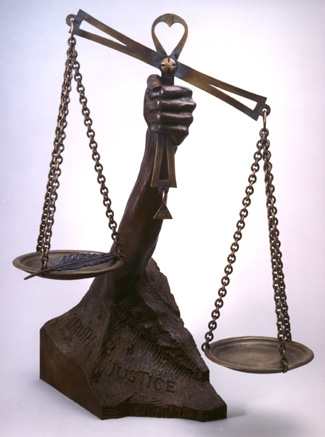
It seems simple, but that is not what is happening. Instead, legislators and administrators are simply cutting on the basis of what's politically easy and what vaguely seems expendable. In education, many administrators are quick to cut athletics, band, cheerleading, art and music because they have the vague impression that those are luxuries. In fact, they are exactly the programs that keep kids in school and build character.Click here to read The New Normal, The New York Times, March 1, 2011.


